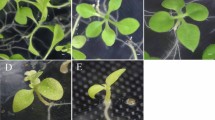Abstract
SUGARCANE × bamboo hybrids were first reported from this Institute by Venkatraman in 19371. In spite of the absence of easily recognizable bamboo characters in the seedlings, Kutty Amma and Ekambaram2 proved by a critical study of the anatomy and morphology of the seedlings that they were genuine hybrids. This corroborated Janaki Animal's3 conclusion arrived at earlier, on the basis of somatic chromosome counts. In these bamboo crosses the pistillate parents employed were the two male sterile Java canes, POJ.213 and POJ.2725. These were themselves complicated bispecies hybrids—POJ.213, involving S. officinarum and S. barberi; POJ.2725, a much more complicated hybrid between a number of officinarumand Java spontaneum (Glagah). It was felt desirable to repeat the cross, using a simple officinarum as the female parent. All the varieties of officinarum so far examined show 2n = 80. For this purpose, S. officinarum var. Vellai (a local form) was employed and two seedlings were obtained. Examining the mother and the two seedlings derived therefrom through pollination with bamboo, one of the seedlings is very thick, much thicker than the mother, more vigorous and taller. The other is much thinner. Examination of the root-tips revealed a somatic chromosome number of 116 in the thick seedling and 86 in the thin. It is believed that the thick seedling has come into being through the fusion of an unreduced egg of S. officinarum (that is, 2n = 80) with a normal sperm of Bambusa arundanacea (n = 36). The thin seedling has presumably been formed by the union of an officinarum egg having neither the haploid nor the diploid number, with the sperm of bamboo. Functioning of diploid eggs in interspecific and intergeneric crosses, involving Saccharum, especially the species officinarum as one of the parents, is not an infrequent phenomenon. Almost all interspecific hybrids between S. officinarum × S. spontaneum have come into being through the operation of the unreduced egg of officinarum. Some cases of intergeneric hybrids are known where both the haploid and diploid eggs have functioned in the same cross. The latest known case is that of S. officinarum var. Vellai × Narenga (2n = 30), where hybrids showing 2n = 95 and 2n = 55 have been obtained (Raghavan unpublished). Functioning of egg with unexpected chromosome number in the formation of sugarcane hybrids is less common. While one such case is known involving a bicomplex hybrid as the pistillate parent, recent investigations have shown that this feature is shared by simple officinarum also. For Co.453, which is a cross between S. officinarum var. Zw. cheribon (2n = 80) and Co.285 (2n = 112), showed a chromosome number of 124, indicating that Zw. cheribon has contributed through its egg neither the haploid number (40) nor its unreduced number (80) but an unexpected number, that is, 684. This report is of interest in three particulars. First, instead of complicated bi-species or tri-species, derivatives such as POJ. or Co. canes, a simple officinarum has been employed as the pistil parent. Secondly, viable embryos are obtained from fertilization of not only haploid gametes, as reported by Janaki Ammal3, but they are also formed from fertilization of unreduced eggs by normal sperms. This brings these bamboo hybrids into a line with Saccharum × Sorghum hybrids, in the formation of which also both reduced and unreduced eggs have been known to function5. Thirdly, the operation of an egg with unexpected chromosome number in the cross has also been vouched for.
This is a preview of subscription content, access via your institution
Access options
Subscribe to this journal
Receive 51 print issues and online access
$199.00 per year
only $3.90 per issue
Buy this article
- Purchase on Springer Link
- Instant access to full article PDF
Prices may be subject to local taxes which are calculated during checkout
Similar content being viewed by others
References
Venkatraman, T. S., J. Agric. Sci., 7, 513 (1937).
Kutty Amma and Ekambaram, J. Ind. Bot. Soc., 18, 209 (1944).
Janaki Ammal, E. K., Nature, 141, 925 (1938).
Raghavan, T. S., Proc. Bien. Conf. Sug. Res. Workers, 47; Curr. Sci., 20, 138 (1951).
Singh, T. S. N., Ind. J. Agric. Sci., 4, 1050 (1934).
Author information
Authors and Affiliations
Rights and permissions
About this article
Cite this article
RAGHAVAN, T. Sugarcane × Bamboo Hybrids. Nature 170, 329–330 (1952). https://doi.org/10.1038/170329b0
Issue Date:
DOI: https://doi.org/10.1038/170329b0
This article is cited by
-
Cytology and genetics of forage grasses
The Botanical Review (1961)
-
The bearing of certain recent cyto-genetical findings on sugarcane breeding
Proceedings / Indian Academy of Sciences (1956)
-
Some aspects of sugarcane breeding in relation to its cyto-genetical peculiarities
Proceedings / Indian Academy of Sciences (1953)
Comments
By submitting a comment you agree to abide by our Terms and Community Guidelines. If you find something abusive or that does not comply with our terms or guidelines please flag it as inappropriate.



